|
 Secure Site
Secure Site
|
 |
Archive for the 'Meditation Tools' Category
 meditation improves attention New research shows that meditation can help you improve your ability to concentrate in two ways. First, it can make you better at focusing on something specific while ignoring distractions. Second, it can make you more capable of noticing what is happening around you, giving you a fuller perspective on the present moment.
Some of the most fascinating research on how meditation affects attention is being conducted by Antoine Lutz, PhD, an associate scientist at the Waisman Laboratory for Brain Imaging and Behavior at the University of Wisconsin at Madison, in collaboration with Richard Davidson and the Laboratory for Affective Neuroscience at the University of Wisconsin. Their work has shown that concentration meditation, in which the meditator focuses complete attention on one thing, such as counting the breath or gazing at an object, activates regions of the brain that are critical for controlling attention. This is true even among novice meditators who receive only brief training. Experienced meditators show even stronger activation in these regions. This you would expect, if meditation trains the brain to pay attention. But extremely experienced meditators (who have more than 44,000 hours of meditation practice) show less activation in these regions, even though their performance on attention tasks is better. The explanation for this, in Lutz’s view, is that the meditation training can eventually help reduce the effort it takes to focus your attention. “This would be consistent with traditional accounts of progress in meditation practice. Sustaining focus becomes effortless,” Lutz says. This suggests that people can immediately enhance concentration by learning a simple meditation technique, and that practice creates even more progress.
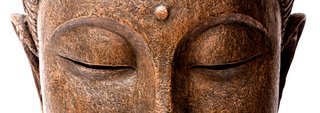 Buddha The researchers also looked at whether vipassana meditation training can improve overall attention. (Vipassana means “to see things as they really are,” and the meditation techniques are designed to increase focus, awareness, and insight.) Researchers label our inability to notice things in our environment as “attentional blink.” Most of us experience this throughout the day, when we become so caught up in our own thoughts that we miss what a friend says to us and have to ask her to repeat it. A more dramatic example would be a car accident caused by your thinking about a conversation you just had and not noticing that the car in front of you has stopped. If you were able to reduce your attentional blink, it would mean a more accurate and complete perception of reality—you would notice more and miss less.
To test whether meditation reduces attentional blink, participants had to notice two things occurring in rapid succession, less than a second apart. The findings, published in PLoS Biology, reveal that the meditation training improved the participants’ ability to notice both changes, with no loss in accuracy.
What explained this improvement? EEG recordings—which track patterns of electrical activity in the brain, showing precise moment-by-moment fluctuations in brain activation—showed that the participants allocated fewer brain resources to the task of noticing each target. In fact, the meditators spent less mental energy no-ticing the first target, which freed up mental bandwidth for noticing what came next. Paying attention literally became easier for the brain.
As a result, Lutz and his colleagues be-lieve that meditation may increase our control over our limited brain resources. To anyone who knows what it’s like to feel scattered or overwhelmed, this is an ap-pealing benefit indeed. Even though your attention is a limited resource, you can learn to do more with the mental energy you already have.
adapted from Yoga Journal, by Kelly McGonigal
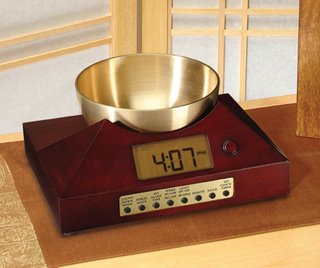 Zen Timepiece with brass singing bowl, a meditation timer Now & Zen
1638 Pearl Street
Boulder, CO 80302
(800) 779-6383
Posted in Bamboo Chime Clocks, intention, Meditation Timers, Meditation Tools, mindfulness practice, Now & Zen Alarm Clocks, Well-being, Yoga Timer
 morning meditation practice with meditation timer Sense the Stillness
You don’t have to be a regular yoga or meditation practitioner to reap the benefits of a morning meditation ritual. Start with five minutes daily, using the guidelines that follow. Then over the course of a few weeks — or when you are ready — gradually work up to 10 minutes. Remember, with meditation it’s quality, not quantity, that matters.
Start with awareness. Rather than lunge out of bed, Novie suggests waking up slowly. “Spend a few minutes just becoming conscious of the sensations of your body. Awareness is such a beautiful way of entering your day.” Once you’re up, resist the temptation to check your e-mail, flip on the radio, or do any of the other countless things that draw you out of yourself and into the concerns of the world. Instead, keep the focus inward.
Find a comfortable spot. Practice your five minutes of meditation anywhere you like (the bedroom floor, a favorite chair) except the bed, where you may fall back to sleep. Be sure to set your Singing Bowl Meditation Timer (Now & Zen, $199.95) for 5 minutes so that your session can end with a calm chime. To enhance the sacred aspect of her meditation space, Novie set up a small altar in her living room that she uses only for meditation, giving the space a positive energy of its own.
Sense your breath. Close your eyes. Feel your breath moving in and out of your body without controlling it. Bring your attention to the rise and fall of your abdomen or to the tip of your nose. The more awareness you bring to breath and body, the more grounded in your body you’ll become. This, in turn, will help relieve some of the stress that comes with getting through your morning.
Don’t try to block your thoughts. Your mind will wander — that’s what it’s designed to do. Rather than try to fight off thoughts as they emerge, acknowledge them, but don’t engage them. And give yourself some slack — meditation is, after all, a practice, not perfection.
For yoga instructor Alison Novie, mornings make an ideal time for meditation — perhaps more than any other time of day. “The sun’s about to rise, but it’s still sort of dark and quiet,” says Novie, who wakes at 5:00 a.m. to meditate. “I get up, brush my teeth, light a candle, and then sit for half an hour. The calm energy I get from that morning meditation carries me through the day.”
adapted from Body + Soul Magazine, March 2006
Our Singing Bowl Meditation Timer called The Zen Timepiece is an acoustic 6-inch brass bowl-gong clock. It is the world’s ultimate alarm clock, practice timer, and “mindfulness bell.”
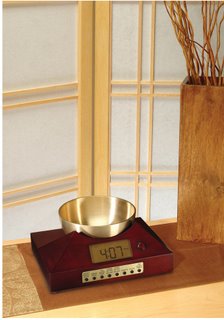 Singing Bowl Meditation Timer is Ideal for Morning Meditation Practice
Now & Zen’s Singing Bowl Meditation Timer Shop
1638 Pearl Street
Boulder, CO 80302
(800) 779-6383
Posted in Chime Alarm Clocks, Meditation Timers, Meditation Tools, mindfulness practice, Well-being, Zen Timers
 Once you experience the Zen Timepiece's progressive tones, you'll never want to meditate any other way. Last week, while trying to get downtown to a conference on integrating stress-reduction techniques into mainstream medicine, I felt my blood pressure rising. I was stuck in traffic, made several wrong turns that took me to the opposite side of the city, and entered a parking garage that turned out to be full—all causing me to miss a much-anticipated keynote speaker. When I finally got to the conference, I couldn’t get beyond my disappointment over missing the opening speaker and sat in the large lecture hall, halfheartedly taking notes and checking my BlackBerry every few minutes. Let’s just say I wasn’t fully present in the moment.
At lunch, I decided to head to a roundtable discussion given by Jon Kabat-Zinn, a psychologist famous for developing a stress-reduction technique called mindfulness, which he’s described in several bestselling books. Can’t hurt, I figured, hoping that he’d begin the session with a little meditation. (You can meditate with him on this YouTube video.) While he did not, in fact, lull me into meditative relaxation, he did very much get me to a mindful state of awareness. “I know you all have questions you’d like to ask or statements you’d like to make,” he said before opening the room up for discussion, “but while you’re waiting your turn, really listen to the other people speaking instead of framing the perfect sentence in your head.”
 It serves as the perfect meditation timer. Available in 5 wood styles, including bamboo. Of course, I thought, I always do that. Then I recalled a roundtable discussion that I’d attended the day before when I was distracted the entire time by trying to get my own question answered. Why isn’t the moderator calling on me? I silently seethed and even went so far as to interrupt another participant asking a question to try to piggyback my query onto his. This time, I resolved, I wasn’t going to ask any questions and was simply going to listen. I also wasn’t going to check my BlackBerry or my watch. I wasn’t going to think about missing the morning speaker or what the traffic would be like heading to my kids’ school for the carpool later that afternoon. I was simply going to, well, be.
I was rewarded with an insider’s look at what healthcare providers discuss among themselves. Many are struggling to help patients make real lifestyle changes. A New Jersey doctor, for example, asked how to deal with a workaholic CEO (a heart attack waiting to happen) who was convinced that cutting back his 70-hour workweek would sacrifice his career. “Most of my best ideas have come out of meditation,” responded Bill George, a Harvard Business School professor and the former chairman and CEO of the healthcare firm Medtronic. “I found that constant interruptions throughout my workday at Medtronic [which has 38,000 employees] left me with incomplete thoughts. Meditation every night gave me that clarity.” So, the solution lies in convincing masters of the universe that less work is actually more—not an easy task.
“I feel like I’m always mopping up problems,” complained another physician, who heads an integrative medicine unit at a university hospital. “I wish my patients would come to me before they’re sick to learn how to stay well.” Kabat-Zinn told him it lies within his power to make his practice what he wants it to be.
Some practitioners shared their own personal stories. A nurse stood up and asked how to get her teenage kids to meditate, something she thought could help them cope with their father’s terminal illness. “I wouldn’t push them,” advised Kabat-Zinn. “That could actually repel them from ever doing it. I’d just keep meditating yourself and spend time with them appreciating the moments, and perhaps they’ll come to it on their own.”
At the end of the session, I felt the same sort of relaxed, euphoric feelings that I generally experience after a workout. It was only after I exited the session that I remembered to check my BlackBerry. Then I shut it off and headed out into the sun of an unexpectedly warm winter day. On my walk back to the parking garage, I made a point of observing sidewalk repairs, guards laughing together by a security station in front of the State Department, and the statue of an ancient Greek posed with a discus at a small park that I passed. I even marveled at the ingenuity of an inner spiral ramp that led me out of the garage. I don’t know why, but those experiences left me calm and at peace with the world, a feeling that lasted until my mind became distracted, once again, by the responsibilities of everyday life.
By SARAH BALDAUF for US News
 It serves as the perfect meditation timer. Available in 5 wood styles, including bamboo. Now & Zen – The Singing Bowl Meditation Timer Shop
1638 Pearl Street
Boulder, CO 80302
(800) 779-6383
orders@now-zen.com
Posted in Meditation Timers, Meditation Tools
 Meditation Practice, Stillness of Being For a formal practice to cultivate equanimity, begin with some calming breaths or a mantra meditation. Once you feel calm, reflect on your desire for happiness and freedom from suffering, both for yourself and for others. Contemplate your desire to serve the needs of others and to be compassionately engaged in the world. Acknowledge both the joy and the suffering that exist throughout the world—the good deeds and the evil ones. As you continue to breathe into your heart’s center, acknowledge the necessity of balancing your desire to make positive change in the world with the reality that you cannot control the actions of others.
Bring to mind the image of someone for whom you have no strong feelings one way or the other. With this person in your mind’s eye, repeat the following phrases to yourself, coordinating with the outbreath if you like:
- All beings like yourself are responsible for their own actions.
- Suffering or happiness is created through one’s relationship to experience, not by experience itself.
- Although I wish only the best for you, I know that your happiness or unhappiness depends on your actions, not on my wishes for you.
- May you not be caught in reactivity.
Feel free to use other similar, appropriate phrases of your own devising. After a few minutes, shift your attention to your benefactors, including teachers, friends, family and the unseen workers who keep the societal infrastructure working. Silently repeat the phrases to yourself as you contemplate these benefactors.
After several minutes, begin to reflect on your loved ones, directing the phrases to them, followed by the difficult people in your life. While feeling kindness, compassion, and joy for those we love comes more easily than it does for those with whom we have difficulty, it is often the opposite with equanimity. It’s a lot easier to accept that those we dislike are responsible for their own happiness than it is for those we care for deeply, because we feel more attachment to them. Whatever your experience, simply note any reactivity and see if you can be equanimous with your reactivity! Broaden your reach after a few minutes to include all beings everywhere throughout the world, and then finally contemplate equanimity in regard to yourself, noticing how taking responsibility for your own happiness and unhappiness can feel the hardest of all.
- All beings, including myself, are responsible for their own actions.
- Suffering or happiness is created through one’s relationship to experience, not by experience itself.
- Although I wish only the best for myself, I know that my happiness or unhappiness depends on my actions, not my wishes for myself.
- May I not be caught in reactivity.
adapted from Yoga Journal by Frank Boccio
Frank Jude Boccio is a teacher of yoga and Zen Buddhism and the author of Mindfulness Yoga. Find him at mindfulnessyoga.net.
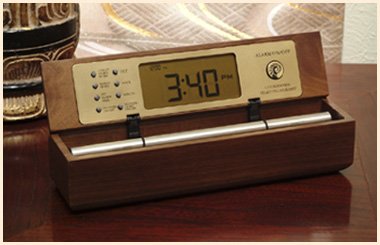 Meditation Timer for Your Meditation Practice The Walnut Digital Zen Clock’s long-resonating Tibetan bell-like chime makes waking up and meditating a beautiful experience – its progressive chimes begin your day with grace. When the clock’s alarm is triggered, the acoustic chime bar is struck just once … 3-1/2 minutes later it strikes again … chime strikes become more frequent over 10 minutes … eventually striking every 5 seconds until shut off. As they become more frequent, the gentle chimes will always wake you up or bring you out of your meditation. Your body really doesn’t need to be awakened harshly, with a Zen Clock you’re awakened more gradually and thus more naturally. Unlike artificial recorded sounds coming out of a tiny speaker in a plastic box, natural acoustic sounds transform your bedroom or office environment.
The Digital Zen Clock also serves as a countdown and interval timer for yoga, meditation, bodywork, etc.; and it can also be set to chime on the hour as a tool for “mindfulness.”
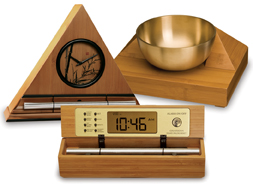 Find the Entire Family of Meditation Timer and Gongs at Now & Zen's Store in Boulder Now & Zen’s Meditation Timer Store
1638 Pearl Street
Boulder, CO 80302
(800) 779-6383
Posted in intention, Meditation Timers, Meditation Tools, mindfulness practice, Well-being, Zen Timers
 Once you experience the Zen Timepiece's progressive tones, you'll never want to meditate any other way. It serves as the perfect meditation timer. KOITSU -- Full Moon at Akashi Beach Study authors say earlier use of such treatments might benefit health-care system
THURSDAY, May 12 (HealthDay News) — Mind-body therapies such as yoga, meditation and deep-breathing exercises appear to be gaining more acceptance in mainstream medicine, according to a new study.
Mind-body therapy is used by more than one-third of Americans, and that number is rising, the researchers noted. They found that one in 30 Americans using some type of mind-body therapy was referred to the treatment by a medical provider.
“There’s good evidence to support using mind-body therapies clinically,” the study’s lead author, Dr. Aditi Nerurkar, an integrative medicine fellow at Harvard Medical School and Beth Israel Deaconess Medical Center in Boston, said in a news release from Beth Israel. “Still, we didn’t expect to see provider referral rates that were quite so high.”
Nerurkar and her colleagues analyzed data from more than 23,000 households that took part in the 2007 U.S. National Health Interview Survey. Nearly 3 percent of the people in those households, or about 6.3 million people, used mind-body therapies after referral by a mainstream medical provider, the study found. These people tended to be sicker and used the health-care system more than people who started using the therapies without a referral.
“What we learned suggests that providers are referring their patients for mind-body therapies as a last resort once conventional therapeutic options have failed,” Nerurkar said. “It makes us wonder whether referring patients for these therapies earlier in the treatment process could lead to less use of the health-care system and, possibly, better outcomes for these patients.”
The study is published in the May 9 issue of Archives of Internal Medicine.
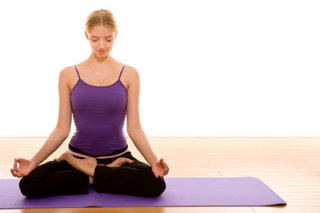 Once you experience the Zen Timepiece's progressive tones, you'll never want to meditate any other way. It serves as the perfect meditation timer. KOITSU -- Full Moon at Akashi Beach “These data suggest that mind-body therapies have really become a mainstream approach to care,” Dr. Russell Phillips, chief of primary care at Beth Israel and the study’s senior author, said in the news release. “But more research is needed to guide physician and patient decision-making regarding their use.”
Meditation is generally an inwardly oriented, personal practice, which individuals do by themselves. Meditation may involve invoking or cultivating a feeling or internal state, such as compassion, or attending to a specific focal point. The term can refer to the state itself, as well as to practices or techniques employed to cultivate the state. There are dozens of specific styles of meditation practice; the word meditation may carry different meanings in different contexts. Meditation has been practiced since antiquity as a component of numerous religious traditions. A 2007 study by the U.S. government found that nearly 9.4% of U.S. adults (over 20 million) had practiced meditation within the past 12 months, up from 7.6% (more than 15 million people) in 2002.
Although meditation can be done in almost any context, practitioners usually employ a quiet, tranquil space, a meditation cushion or bench, and some kind of timing device to time the meditation session. Ideally, the more these accoutrements can be integrated the better. Thus, it is conducive to a satisfying meditation practice to have a timer or clock that is tranquil and beautiful. Using a kitchen timer or beeper watch is less than ideal. And it was with these considerations in mind that we designed our Gong Meditation Timer. This unique “Zen Clock” features a long-resonating acoustic chime that brings the meditation session to a gradual close, preserving the environment of stillness while also acting as an effective time signal. The Digital Zen Clock can be programmed to chime at the end of the meditation session or periodically throughout the session as a kind of sonic yantra. The beauty and functionality of the Gong Meditation Time/Clock makes it a meditation tool that can actually help you “make time” for meditation in your life.
More information: The U.S. National Institutes of Health has more about mind-body therapy. — Robert Preidt
SOURCE: Beth Israel Deaconess Medical Center, news release, May 9, 2011
 The Gong Meditation Timer Shop, Boulder, Colorado Now & Zen – The Gong Meditation Timer Store
1638 Pearl Street
Boulder, CO 80302
(800) 779-6383
orders@now-zen.com
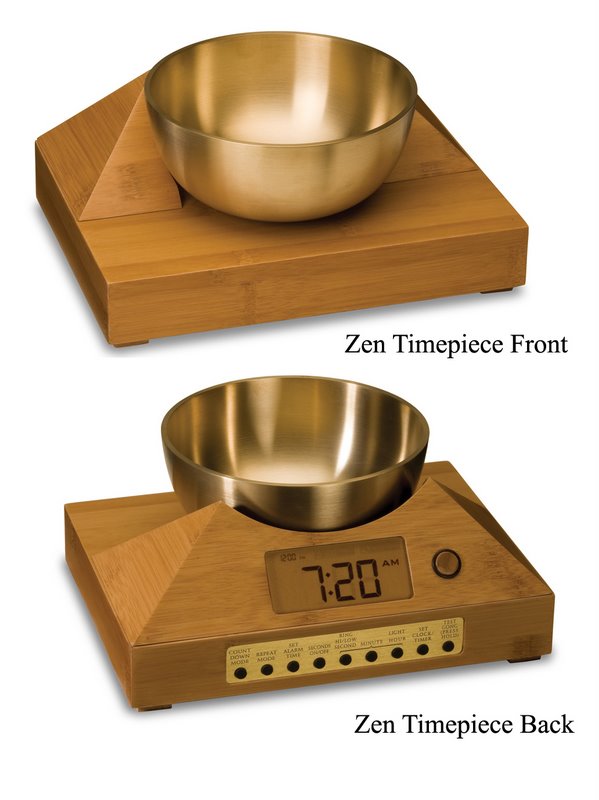 Once you experience the Zen Timepiece's progressive tones, you'll never want to meditate any other way. It serves as the perfect meditation timer.
Posted in Meditation Timers, Meditation Tools
 Our Yoga Timer & Clock can be programmed to chime at the end of the meditation or yoga session or periodically throughout the session as a kind of sonic yantra. Study: Even a Cram Course in Meditation Helps Reduce Pain
Meditation might beat morphine as a painkiller, new research suggests. In a small study, healthy medical students attended four 20-minute sessions to train them in “mindfulness meditation,” based on techniques such as focusing on breathing and banishing of distracting thoughts. Before and after the training, participants underwent brain scans with a pad heated to a painful 120 degrees attached to the back of their leg. They reported a 40 percent decrease in pain intensity and a 57 percent reduction in pain unpleasantness following their training. Morphine and similar drugs typically reduce pain by about 25 percent. Meditation reduced activity in key pain-processing regions of the brain, according to findings published Wednesday in the Journal of Neuroscience. “We found a big effect,” study author Fadel Zeidan, a research fellow at Wake Forest Baptist Medical Center, said in a press statement. “This study shows that meditation produces real effects in the brain and can provide an effective way for people to substantially reduce their pain without medications.”
 Bring Yourself Back to Balance Use our unique “Zen Clock” which functions as a Yoga & Meditation Timer. It features a long-resonating acoustic chime that brings your meditation or yoga session to a gradual close, preserving the environment of stillness while also acting as an effective time signal. Our Yoga Timer & Clock can be programmed to chime at the end of the meditation or yoga session or periodically throughout the session as a kind of sonic yantra. The beauty and functionality of the Zen Clock/Timer makes it a meditation tool that can actually help you “make time” for meditation in your life. Bring yourself back to balance.
By ANGELA HAUPT for US News
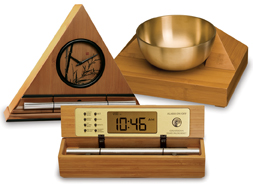 The beauty and functionality of the Zen Clock/Timer makes it a meditation tool that can actually help you "make time" for meditation in your life Now & Zen – The Chime Meditation Timer Store
1638 Pearl Street
Boulder, CO 80302
(800) 779-6383
orders@now-zen.com
Posted in Meditation Tools, mindfulness practice
 Once you experience the Zen Timepiece's progressive tones, you'll never want to meditate any other way. Mindfulness researcher Jon Kabat-Zinn explains how to live in the moment
There’s a movement afoot—at least among those who practice what’s known as “integrative medicine”—to focus on maintaining a state of optimal health rather than simply alleviating symptoms or treating a particular disease. These docs, nurses, and other health practitioners want us to be truly mindful of how we choose to nourish ourselves with food, activity, rest, and connections with others. In other words, what are we doing to keep from getting sick in the first place? That’s the question we need to ask ourselves every day, moment to moment, contends psychologist Jon Kabat-Zinn, founding director of the University of Massachusetts Medical School’s Center for Mindfulness in Medicine.
Studies have shown that mindfulness, a form of meditation in which you disengage yourself from strong beliefs, thoughts, and emotions, has a positive effect on brain function, lowering the stress response and increasing feelings of relaxation and well-being. It involves being truly present, even during those simple, mundane activities like washing dishes. It can remind you of the “reality of impermanence,” Kabat-Zinn writes in his bestselling book Full Catastrophe Living. “Here you are doing the dishes again. How many times have you done the dishes? How many more times will you do them in your life? What is this activity we call doing the dishes? Who is doing them? Why?”
At last week’s Institute of Medicine conference on integrative health, he outlined five strategies for using mindfulness to improve one’s health and achieve wellness.
1. Consider what‘s right with you. “Until you stop breathing, there’s more right with you than wrong with you,” says Kabat-Zinn. Every day, take a moment to thank your eyes for seeing, your liver for functioning, your feet for carrying you from place to place. Heck, thank those mitochondria within your cells for pumping out the energy you need to get you out of bed in the morning.
2. Love yourself unconditionally. Hate yourself for being 40 pounds overweight? Those berating thoughts you have about your imperfections can actually derail you instead of motivating you into action. (It’s that old story: Starve yourself as punishment for overeating, until you can’t take it anymore and give in to a binge.) Rather than setting a weight-loss goal and promising to love yourself once you get there, Kabat-Zinn says you need to make an effort to love yourself “all the way,” whether you’re 300 pounds or 150. If you decide to eat smaller portions or give up chips for carrot sticks, simply tell yourself, “This is just the way I’m eating now as a way to live better.”
3. Live in the present moment. Don’t think about what you ate yesterday or make promises to exercise tomorrow. “Every moment gives you the ability to learn, grow, and change,” explains Kabat-Zinn. “If you can take a moment and live as if it really mattered, you can take a step back and see those impulses that may be negative to your health.” What’s more, you’ll truly enjoy those indulgences like the creamy feel of a Godiva truffle or a 10-minute shoulder massage at an airport kiosk when your flight is delayed. You can also take pleasure in those small interactions with others: with the doorman, greeting you in your office lobby; the lady in line ahead of you at the supermarket; the goodnight hug from yourchild.
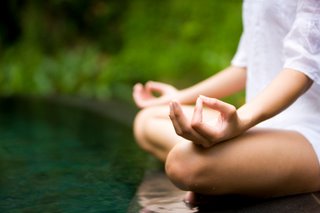 Our Gong Meditation Timer's exquisite sounds summon your consciousness out of your meditative state with a series of subtle gongs 4. When life gets tough, don‘t take it personally. When faced with job loss, a foreclosure, or an impending divorce, it’s really hard not to place the blame squarely on your own shoulders and get stuck in the “if only” mind-set. If only I had (choose one): taken a different job, bought a cheaper house, not cheated. That sort of rumination sets you up for full-blown depression. While it’s important to accept responsibility for your actions, the best way to do that is by looking to the present rather than the past. What are you going to do that’s different right now, at this moment, to move forward? “When the proverbial stuff hits the proverbial fan, it’s really important to recognize and acknowledge the fear you’re feeling,” says Kabat-Zinn. “But also recognize that it’s in these trying times that you will understand fully what it means to be human, to utilize all the resources you have.” After all, it’s those challenges faced by the World War II generation that earned it the distinction of being called the “greatest.”
5. Put the “being“ back in human. If you fill every moment with frenetic activity—work, text messaging, household chores, computer games—you never give yourself a chance to simply be. Too many of us are human stuff, the sum of our actions, instead of human beings, points out Kabat-Zinn. As corny as it sounds, just sitting for a moment to contemplate the clouds, the smell of freshly brewed coffee, the pattern of stalled cars winding around the freeway, is what separates us from the nut-gathering squirrels. And science shows it’s a great stress reliever, to boot.
Use our unique “Zen Clock” which functions as a Gong Yoga & Meditation Timer. It features a long-resonating acoustic chime that brings your meditation or yoga session to a gradual close, preserving the environment of stillness while also acting as an effective time signal. Our Yoga Timer & Clock can be programmed to chime at the end of the meditation or yoga session or periodically throughout the session as a kind of sonic yantra. The beauty and functionality of the Zen Clock/Timer makes it a meditation tool that can actually help you “make time” for meditation in your life. Bring yourself back to balance.
By DEBORAH KOTZ for US News
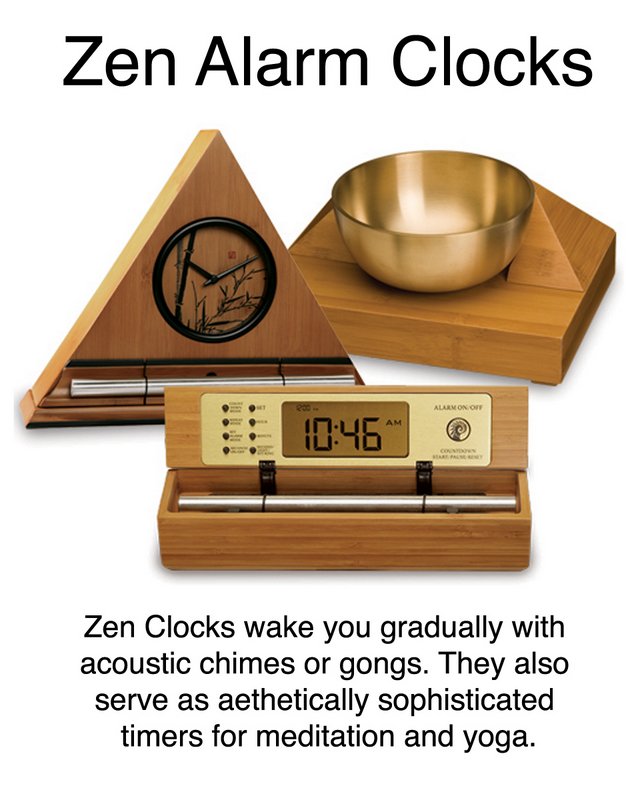 Bring yourself back to balance.
Posted in Meditation Tools
 Once you experience the Zen Timepiece's progressive tones, you'll never want to meditate any other way. New research indicates chanting and meditation help enhance mind/body health and balance. A study by the University of California-San Diego, the Alzheimer’s Prevention Foundation International, and the Amen Clinic of Newport Beach, California, found that Kirtan Kriya, a simple twelve minute Kundalini yoga meditation, increased oxygen delivery, blood flow, and energy in the brain, while improving neurotransmitter (chemical messengers of the brain that communicate with the body) function.
Kirtan Kriya involves chanting the Sanskrit words ‘Sa’ (meaning birth or cosmos), ‘Ta’ (life), ‘Na’ (completion), and ‘Ma’ (signifying rebirth). Here’s how to practice it: Repeat ‘Sa Ta Na Ma’ with your eyes closed while sitting with a straight spine; focus your mental energy on the area between your eyebrows. For two minutes, chant in your normal speaking voice; for the following three minutes, whisper. For the next three minutes, chant silently. Then reverse the order; whispering for two minutes and chanting the mantra aloud for two minutes. Enjoy your enlightenment!
 It's exquisite sounds summon your consciousness out of your meditative state with a series of subtle gongs. Use our unique “Zen Clock” which functions as a Yoga & Meditation Timer. It features a long-resonating acoustic chime that brings your meditation or yoga session to a gradual close, preserving the environment of stillness while also acting as an effective time signal. Our Yoga Timer & Clock can be programmed to chime at the end of the meditation or yoga session or periodically throughout the session as a kind of sonic yantra. The beauty and functionality of the Zen Clock/Timer makes it a meditation tool that can actually help you “make time” for meditation in your life. Bring yourself back to balance.
adapted from Healinglifestyles.com by Kyle Roderick
 Zen Alarm Clocks, made by Now & Zen, Inc., come in a variety of shapes and sizes. Now & Zen – The Tibetan Singing Bowl Meditation Timer
1638 Pearl Street
Boulder, CO 80302
(800) 779-6383
orders@now-zen.com
Posted in Meditation Timers, Meditation Tools, mindfulness practice
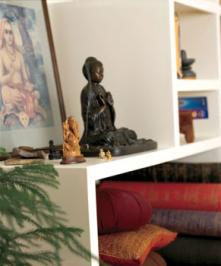 creating a meditation space in your home • It doesn’t really matter where your meditation space is located in your house, although Rodney Yee says the Balinese consider the northeast corner culturally and religiously auspicious. Tias Little likes the southeast corner because it captures morning light for early meditation. Basically, says Yee, pick a space where you feel relaxed and comfortable. “I think everybody has a special little place where they go to be quiet—just like a cat that searches until it finds the right spot to sleep.”
• You can think big thoughts in any size space. Your meditation area can be as expansive as Richard Freeman’s, a room “at the very top of the house, encompassed by a big maple tree,” or simply a spare closet or an empty corner. Rainbeau Mars likes a window for fresh air as long as it’s not distracting, but Little says a semi-enclosed space can give a “really spectacular feeling, like a little womb.” You might consider creating a six- or seven-foot-square adobe “cell” addition to your house or yard.
 meditation space • “Anyone can use [a meditation space], but only for meditation,” Deepak Chopra says. Freeman says to minimize distraction, you should choose a location that’s as isolated as possible from the traffic flow in your house, and it shouldn’t be in an area where you’re more tempted to sleep than meditate. If you share your space, each person should have his or her own chair, cushion, zabuton mat, or zafu pillow, “something that sanctifies this is my space,” Mars says. Sit on it only when you meditate. That helps create a ritual conducive to meditation, Judith Hanson Lasater says. It is nice to have a special Zen Meditation Timer on a table beside your the chair or cushion that you meditate on. This way you can easily reach the meditation timer to turn it off when it chimes and then you can continue to sit in peace until ready to move.
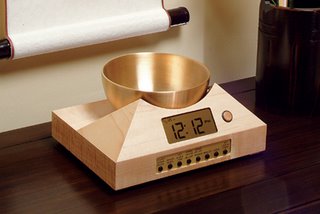 Zen Timepiece, a brass singing bowl clock and timer • Tatami mats or bare wood floors are a better, cleaner option than rugs or carpets, and they create a more spacious feeling, Little says.
• An altar is a good idea. “When you set it up, the space begins to get that special feeling,” Yee says. An altar makes it clear the space is reserved for meditation and serves as a repository for your sacred objects and decorations. It needn’t be elaborate: Little has seen window sills used as altars. Yee’s altar is a small, low table covered with a Balinese cloth; Freeman’s is a stone slab.
• If you do yoga in your meditation space, store props such as mats, blocks, and straps in a chest. Leaving them out creates distracting clutter.
• Avoid bright overhead lighting, or use a dimmer switch. Lamps or sconces are best because they combine illumination with warmth.
• Include a timer. Meditation is all about discipline and consistency, and meditating a set amount of time each day can help achieve that, Lasater says. The Zen Timepiece chimes gently at the end of one’s meditation without startling one back to the here and now.
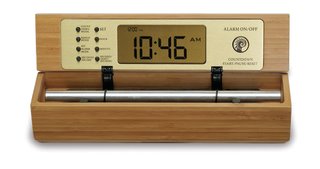 Bamboo Zen Meditation Timer • Even experts disagree on how to decorate your space. Most are minimalists. “It needs to be elegant in its simplicity and with very little clutter,” Chopra says. His recommended decorations include candles, books, and symbolic representations of archetypal figures such as gods, goddesses, angels, flowers, incense, and pastel colors. “You should not include anything that symbolically represents violence,” he adds. Yet not everyone finds minimalism calming, points out Freeman. “Some people display every saint they’ve ever heard of; some people may have only one. Others might light a candle; others prefer nothing. It’s whatever makes you want to sit there and do nothing.”
adapted from Natural Home Magazine, Jan/Feb 2005 by Vicky Uhland
Posted in Bamboo Chime Clocks, Japanese Inspired Zen Clocks, Meditation Timers, Meditation Tools, mindfulness practice, Well-being, Zen Timers
 Try a Listen Meditation as a Mindfulness Practice Listening Meditation
Instructor Sally Kempton is a spiritual guide who teaches yoga and meditation at her Carmel, Calif.-based Awakened Heart Meditation (sallykempton.com). She authored The Heart of Meditation under her monastic name Swami Durgananda.
What is it? While many meditation techniques require solitude and silence, this one has you engage with the sounds all around you; it invites you to work with and use the noise instead of fighting it. Listening meditation also encourages you to harmonize with your surroundings, and, by extension, the universe. The intent is to experience sound as vibration, rather than information. The listening practice is a way of interacting with the environment that allows you to take in the whole energy of the present moment, says Kempton.
What’s it good for? Especially adaptable and portable, listening meditation can be practiced in crowded, noisy situationson a bus, at the office that would be hard on other styles. (Kempton once led a listening meditation workshop in the middle of a busy Whole Foods store!) People with particularly chattering minds may need to couple this practice with a mantra or breathing meditation. However, many people welcome the chance to focus outward rather than inward and find that listening meditation is one of the easier techniques to undertake. You’ll come away from it feeling refreshed, expanded, and at ease with your environment, declares Kempton.
How long does it take? Try for five minutes at first, then add a minute or two until you can do it for 15 or 20 minutes at a time. Set your Chime Meditation Timer by Now & Zen for five minutes and then increase as you get better at this practice.
How Do I Do It?
1. Set your Meditation Chime Timer for 5 minutes (increase the minutes as you improve). Sit in a comfortable position and close (or half close) your eyes.
2. To get centered and quiet the mind, first bring your awareness to your breath, noticing but not trying to change it.
3. Now open your ears and bring your awareness to the sounds around you. The goal is to listen to the whole range of sounds, without favoring one over another and without identifying them. Hear the quiet sounds and the silences as well as the dominant sounds.
4. When you find yourself identifying sounds (there’s a fire engine; thats the cat scratching the rug), gently redirect your attention from listening to a specific noise back to hearing the whole spectrum of sounds.
5. To end, slowly open your eyes, stand, and carry this heightened awareness with you for as long as you can.
Tip: Do a one-minute mini-listening meditation while standing in line or sitting at your desk, or anytime you feel frazzled: Close your eyes, breathe, and listen to the sounds around you. Like the practice of counting to 10 when you’re in the heat of an argument, this will help you pause, center, and regroup.
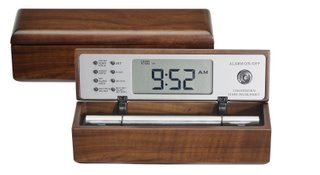 Zen Meditation Timers, The Digital Zen Alarm Clock in Solid Walnut adapted from Natural Health Magazine
Now & Zen’s Chime Time Store
1638 Pearl Street
Boulder, CO 80302
(800) 779-6383
Posted in Bamboo Chime Clocks, Chime Alarm Clocks, intention, Meditation Timers, Meditation Tools, mindfulness practice, Well-being, Zen Timers
« Previous Page — « Previous Entries
Next Entries » — Next Page »
|
|
|
|





























